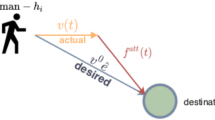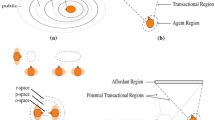Abstract
Path planning is one of the most widely studied problems in robot navigation. It deals with estimating an optimal set of waypoints from an initial to a target coordinate. New generations of assistive robots should be able to compute these paths considering not only obstacles but also social conventions. This ability is commonly referred to as social navigation. This paper describes a new socially-acceptable path-planning framework where robots avoid entering areas corresponding to the personal spaces of people, but most importantly, areas related to human-human and human-object interaction. To estimate the social cost of invading personal spaces we use the concept of proxemics. To model the social cost of invading areas where interaction is happening we include the concept of object interaction space. The framework uses Dijkstra’s algorithm on a uniform graph of free space where edges are weighed according to the social traversal cost of their outbound node. Experimental results demonstrate the validity of the proposal to plan socially-accepted paths.
Access this chapter
Tax calculation will be finalised at checkout
Purchases are for personal use only
Similar content being viewed by others
Notes
- 1.
The actual detection of humans is out of the scope of the paper. In the experiments carried out it was performed by the Human agent of the CORTEX architecture.
References
Gomez, J., Mavridis, N., Garrido, S.: Social path planning: generic human-robot interaction framework for robotic navigation tasks. In: Workshop on Cognitive Robotics Systems: Replicating Human Actions and Activities at IEEE/RSJ International Conference on Robots and Systems (2013)
Lichtenthaler, C., Peters, A., Griffiths, S., Kirsch, A.: Social navigation - identifying robot navigation patterns in a path crossing scenario. In: Lecture Notes in Computer Science, vol. 8239, pp. 84–93 (2013)
Charalampous, K., Kostavelis, I., Gasteratos, A.: Robot navigation in large-scale social maps: an action recognition approach. Expert Syst. Appl. 66, 261–273 (2016)
Vega, A., Manso, L., Bustos, P., Núñez, P., Macharet, D.: Socially aware robot navigation system in human-populated and interactive environments based on an adaptive spatial density function and space affordances. Pattern Recogn. Lett. 1, 72–84 (2019)
Foux, G., Heymann, M., Bruckstein, A.: Two-dimensional robot navigation among unknown stationary polygonal obstacles. IEEE Trans. Robot. Autom. 9, 96–102 (1993)
Weihua, C., Tie, Z., Yanbiao, Z.: Mobile robot path planning based on social interaction space in social environment. Int. J. Adv. Rob. Syst. 1, 1–10 (2018)
Kruse, T., Pandey, A., Alami, R., Kirsch, A.: Human-aware robot navigation: a survey. Robot. Auton. Syst. 61(12), 1726–1743 (2013)
Rios-Martinez, J., Spalanzani, A., Laugier, C.: From proxemics theory to socially-aware navigation: a survey. Int. J. Soc. Robot. 7(2), 137–153 (2015)
Rios-Martinez, J.: Socially-aware robot navigation: combining risk assessment and social conventions. Ph.d. Inria, France (2013)
Althaus, P., Ishiguro, H., Kanda, T., Miyashita, T., Christensen, H.I.: Navigation for human robot interaction tasks. In: IEEE International Conference on Robotics and Automation, vol. 1, pp. 1894–1989 (2004)
Kirby, R., Simmons, R., Forlizzi, J.: COMPANION: a constraint-optimizing method for person-acceptable navigation. In: IEEE International Symposium on Robot and Human Interactive Communication, pp. 607–612 (2009)
Tranberg Hansen, S., Svenstrup, M., Andersen, H.J., Bak, T.: Adaptive human aware navigation based on motion pattern analysis. In: IEEE International Symposium on Robot and Human Interactive Communication, pp. 927–932 (2009)
Photchara, R., Mae, Y., Ohara, K., Kojima, M., Arai, T.: Social navigation model based on human intention analysis using face orientation. In: IEEE/RSJ International Conference on Intelligent Robots and Systems. vol. 1, pp. 1682–1688 (2010)
LaValle, S.: Planning Algorithms. Cambridge University Press, Cambridge (2006)
Lam, C., Chou, C., Chiang, K., Fu, C.: Human-centered robot navigation - towards a harmoniously human-robot coexisting environment. IEEE Trans. Rob. 27(1), 99–112 (2011)
Bustos, P., Manso, L., Bandera, A., Bandera, J.P., García-Varea, I., Martínez-Gómez, J.: The CORTEX cognitive robotics architecture: use cases. Cogn. Syst. Res. 55, 107–123 (2019)
Okal, B., Arras, K.: Learning socially normative robot navigation behaviors with Bayesian inverse reinforcement learning. In: IEEE International Conference on Robotics and Automation, pp. 2889 – 2895 (2016)
Kostavelis, I.: Robot behavioral mapping: a representation that consolidates the human-robot coexistence. Robot. Autom. Eng. 1, 1–3 (2017)
Acknowledgment
This work has been partially supported by the National project RTI2018-099522-B-C42. by the Extremaduran Government projects GR15120, IB18056 and by the FEDER project 0043-EUROAGE-4-E (Interreg V-A Portugal-Spain - POCTEP).
Author information
Authors and Affiliations
Corresponding author
Editor information
Editors and Affiliations
Rights and permissions
Copyright information
© 2020 Springer Nature Switzerland AG
About this paper
Cite this paper
Vega, A., Cintas, R., Manso, L.J., Bustos, P., Núñez, P. (2020). Socially-Accepted Path Planning for Robot Navigation Based on Social Interaction Spaces. In: Silva, M., Luís Lima, J., Reis, L., Sanfeliu, A., Tardioli, D. (eds) Robot 2019: Fourth Iberian Robotics Conference. ROBOT 2019. Advances in Intelligent Systems and Computing, vol 1093. Springer, Cham. https://doi.org/10.1007/978-3-030-36150-1_53
Download citation
DOI: https://doi.org/10.1007/978-3-030-36150-1_53
Published:
Publisher Name: Springer, Cham
Print ISBN: 978-3-030-36149-5
Online ISBN: 978-3-030-36150-1
eBook Packages: Intelligent Technologies and RoboticsIntelligent Technologies and Robotics (R0)




